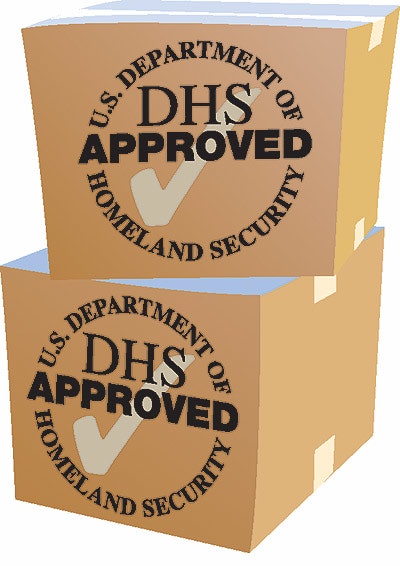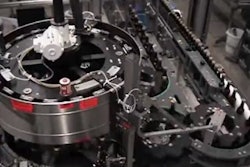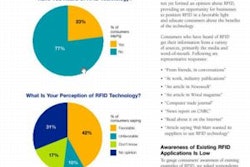Terrorism prevention and response isn’t just for firefighters and police anymore. Packagers are on alert, too.
And the technologies they will have available to detect packaging infiltration and track contamination incidents are ready to expand considerably because of the Department of Homeland Security’s (DHS) upcoming certification of anti-terrorism products.
The DHS published an interim final rule in October on implementation of the SAFETY Act, a law that gives manufacturers (and ostensibly users) of anti-terrorism technologies some concessions with regard to liability and the purchase of anti-terrorism insurance if their products meet certain criteria. The law was meant to stimulate development of products such as respirators and decontamination suits for chemical, biological, radiological, and nuclear applications. But the law was also strongly supported by companies such as Sara Lee, Kellogg, Nestlé, Coca-Cola, Pepsico, Johnson & Johnson, and Pfizer.
Packaged goods companies are hoping that DHS now certifies radio-frequency identification (RFID) tags as an anti-terrorism technology so these companies can use the tags on their packaging and advertise the fact that the packages are certified by the DHS. No one yet is talking about label language.
“If we get a declaration from Homeland Security that this is the step we need to take to protect the food supply, that’s the step it will take to move this technology forward,” said Procter & Gamble supply-chain executive Larry Kellam at an RFID industry conference in June.
Could stimulate RFID
DHS certifications of packaging security technologies are apt to have a much wider impact on use of RFID tags and other innovations than either the better-publicized Wal-Mart mandate or the recent Department of Defense requirement that suppliers put passive RFID tags on the lowest possible piece part/case/ pallet packaging by January 2005. For example, Wal-Mart is focusing on its top 100 suppliers, and only those who do business in Texas.
Jeff Hehir, senior director of supply chain solutions for Georgia-Pacific Corp., which is working fast and furious to develop a pool of reusable plastic containers (RPCs) for growers that can display the RFID tags, says he doubts any of Wal-Mart’s top 100 are food suppliers. The same is probably true for OTC drug marketers. The DOD requirement will affect mostly suppliers of industrial products, not consumer goods.
U.S. packaged goods companies are beginning to test RFID tags. Boston-based Gillette Company has a very limited field test program running out of one packaging and distribution warehouse where RFID tags are being placed on pallets and cases of Venus razors. Gillette is testing the tags for inventory and supply chain purposes, not for security. Paul Fox, a spokesman for Gillette, says Gillette has cooperated with United Kingdom retailer Tesco in a shelf-level test in Europe where the tags are placed on the packages of Mach 3 razors. “So far, it’s hearsay, but we understand Tesco is very pleased with that field trial,” says Fox.
Tags are unlikely to be routinely affixed to packages for awhile, though. Cost is one reason. “They would have to cost a fraction of a penny for that to happen,” Fox advises. “The reason we can consider using them on pallets and boxes is that their price has come down from two dollars a tag a few years ago to less than ten cents a tag.”
Need for specs
Another current roadblock to the more widespread use of RFID tags is the absence of technical standards, which the DHS says it will look for during the product certification process. The Uniform Code Council, Inc. and the EAN International have formed a new standards group called EPCglobal, Inc., that will press for multi-industry adoption of the Electronic Product Code (EPC).
Specifications for this RF technology were developed by the MIT Auto-ID Center, which then transferred the intellectual property to EPCglobal. It opened for business in September and gets its first president early in 2004. Jack Grasso, spokesman for the Lawrenceville, NJ-based UCC, says there are three work groups busy translating the RF tag specifications into standards. The UCC is hoping the Department of Homeland Security certifies its standards under the SAFETY Act.
While discussion of packaging security has so far been limited to “track and trace” technologies, there are other important on-the-cusp developments that have received little attention from packagers.
Biosensing, too
Biological sensors are also being studied. For example, IntraMicron, Inc., has begun to manufacture a “microfibrous media”—it is made like paper—that contains what are called sorbents and catalysts to trap bad actors like botulism and anthrax. IntraMicron injects the media with either metal or polymeric fibers, which are then either welded or molded into the media. The fibers serve to collect and concentrate whatever is roaming around inside a package, including bad odors. Doug Drablos, director of business development for IntraMicron, says the first application of the media is for use in respirators.
Jeff Hehir at Georgia-Pacific calls the technology “pretty cool.” Georgia-Pacific had considered licensing the technology, developed by Auburn University, which holds the patents. But G-P decided against it, at least for the time being.
Researchers at the University of Wisconsin in Madison have gone Auburn one better by developing DNA-modified diamond films that can be used on the outside of the package to detect bioterrorism threats. Because diamond film can be deposited on an RFID tag, it could provide a bridge between the world of miniature electronics and biology, which requires a chemically stable platform for biosensing.
The film can be used to detect anthrax, ricin, bubonic plague, smallpox, and other molecules. “This is where we are going and we are almost there. We’ve proven that we can detect the electrical response when biomolecules bind to the diamond surface,” says Robert Hamers, a professor of chemistry at UW. Hamers acknowledges that before the new biosensors become practical, significant engineering for packaging and fluid-handling systems for sample introduction must be completed.
But while some work remains, he says, “the hardest part appears to be over.”

























